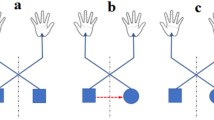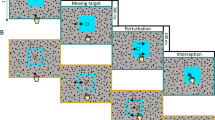Summary
We have studied fast arm movements in response to double-step stimuli in two-dimensional space. In a previous paper we found that such movements did not start in the direction of the first or the second target, but in a direction between the two targets. The initial movement direction was found to depend in a continuous fashion on the inter-stimulus interval and on the reaction time. Therefore we concluded that the internal representation of a discrete target displacement is a gradually shifting internal target, moving from the first to the second target location. In this paper we investigate whether the arm movements also show a modification of the trajectory during the movement. An inter-stimulus interval of 100 ms was chosen, because then the initial movement direction is the same as in the response to a single-step displacement. We found that on average double-step trajectories deviate significantly from their original trajectory within 60 ms, and in some cases even within 30 ms of the start of the movement. We conclude that a motor programme is centrally modified according to a changed target location. We hypothesize that the generation of the motor programme starts after the target presentation, and that the activation levels for the appropriate muscles are continuously adjusted to move the hand in the direction of the current internal representation of the target.
Similar content being viewed by others
References
Aslian RN, Shea SL (1987) The amplitude and angle of saccades to double-step target displacements. Vision Res 27:1925–1942
Findlay JM, Harris LR (1984) Small saccades to double-stepped targets moving in two dimensions. In: Gale AG, Johnson F (eds) Theoretical and applied aspects of eye movement research. Elsevier Science Publishers BV, pp 71–78
Fisk JD, Goodale MA (1985) The organization of eye and limb movements during unrestricted reaching to targets in contralateral and ipsilateral visual space. Exp Brain Res 60:159–178
Forssberg H, Grillner S, Rossignol S (1977) Phasic gain control of reflexes from the dorsum of the paw during spinal locomotion. Brain Res 132:121–139
Georgopoulos AP, Kalaska JF, Massey JT (1981) Spatial trajectories and reaction times of aimed movements: effects of practice, uncertainty and change in target location. J Neurophysiol 46:725–743
Gielen CCAM, Heuvel PJM van den, Gisbergen JAM van (1984a) Coordination of fast eye and arm movements in a tracking task. Exp Brain Res 56:154–161
Gielen CCAM, Heuvel PJM van den, Denier van der Gon JJ (1984b) Modification of muscle activation patterns during fast goaldirected arm movements. J Motor Behav 16:2–19
Gisbergen JAM van, Opstal AJ van, Roebroek JGH (1987) Stimulus-induced midflight modification of saccade trajectories. In: O'Regan JK, Levy-Shoen A (eds) Eye movements: from physiology to cognition. Elsevier Science Publ BV, pp 27–36
Gottsdanker R (1973) Psychological refractoriness and the organization of step-tracking responses. Percept Psychophys 14:60–70
Henry FM (1960) Increased response latency for complicated movements and a “memory-drum” theory of neuromotor reaction. Res Q 31:448–458
Keele SW (1968) Movement control in skilled motor performance. Psychol Bull 70:387–403
Keele SW (1981) Behavioral analysis of movement. In: Brooks VB (ed) Handbook of physiology: the nervous system, Vol II. Motor control, Part 2. Am Physiol Society, Bethesda, Md, pp 1391–1414
Massey JT, Schwartz AB, Georgopoulos AP (1986) On information processing and performing a movement sequence. In: Heuer H, Fromm C (eds) Generation and modulation of action patterns. Exp Brain Res Series 15:242–251
Megaw ED (1974) Possible modification to a rapid on-going programmed manual response. Brain Res 71:425–441
Miles FA, Evarts EV (1979) Concepts of motor organization. Ann Rev Psychol 30:327–362
Russell DG (1976) Spatial location cues and movement production. In: Stelmach GE (ed) Motor control: issues and trends. Academic Press, New York, pp 67–85
Schmidt RA (1982) Motor control and learning, a behavioral emphasis. Human Kinetics Publishers, Champaign Ill
Sittig AC, Denier van der Gon JJ, Gielen CCAM (1987) The contribution of afferent information on position and velocity to the control of slow and fast human forearm movements. Exp Brain Res 67:33–40
Sonderen JF van, Denier van der Gon JJ, Gielen CCAM (1988) Conditions determining early modification of motor programmes in response to changes in target location. Exp Brain Res 71:320–328
Woltring HJ (1986) A Fortran package for generalized, cross-validatory spline smoothing and differentiating. Adv Eng Software 8:104–113
Author information
Authors and Affiliations
Rights and permissions
About this article
Cite this article
van Sonderen, J.F., Gielen, C.C.A.M. & van der Gon Denier, J.J. Motor programmes for goal-directed movements are continuously adjusted according to changes in target location. Exp Brain Res 78, 139–146 (1989). https://doi.org/10.1007/BF00230693
Received:
Accepted:
Issue Date:
DOI: https://doi.org/10.1007/BF00230693




